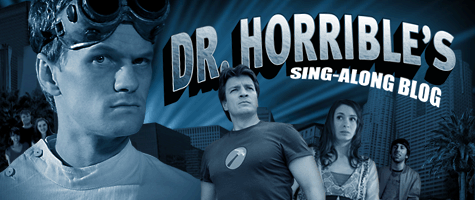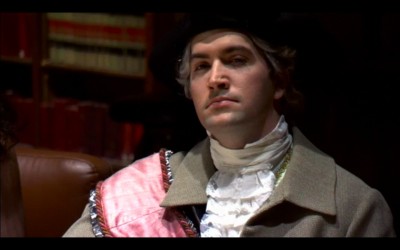Andi, I enjoyed reading your post from Saturday, as I'm struggling myself to think about how to teach visual rhetoric in my classroom-although, the concerns I'm undergoing are much different from yours. There may be ethical concerns about using podcasts to teach a variety of songs united around a different theme, but most of what I do will involve looking at pretty pictures.

Credit: Dr. Horrible's Sing-Along Blog
As I'm moving from unit one (where we've focused on introducing the basic terms of rhetorical study and mastering discussions of musical lyrics and songs) into unit two (where we'll begin watching full musicals and stage performances), I had the students watch Dr. Horrible's Sing-Along Blog as an example of a short musical (link to the musical in full here), and discuss how it relates to American values. On Friday we'll move into a discussion of visual rhetoric by looking back visually at Dr. Horrible (to save time), but I'm struggling to think about how to discuss the visual elements not just of the static photo, which can be easily captured, but also the moving image.
What kind of language is necessary to talk about how running a hand through one's hair builds ethos? Some of the static imagery should be easy: as with the pictures below, where the shift in Dr. Horrible's color-coordinated costume signifies a move from innocence to experience/evil:
However, while delivery is one of the five classical canons of rhetoric, it doesn't get much play in modern textbooks. If anybody can recommend any sources to me, I'd be happy to test them out on my students. I imagine we might end up adapting a vocabulary from performance studies to serve rhetorical purposes, which should work. I'd appreciate having something more to say than just pointing out Evil Thomas Jefferson to them, though.

Credit: Dr. Horrible Screencaps
Comments
Mad Scientist Makeover
I have no help to offer--just a distraction: Dr. Horrible (aka Billy) is yet another scientist driven to seek world domination with single-minded zeal due to his wimpy physique and failure with the ladies. Watching the episodes made me wonder: where’s the bad-ass scientist in visual culture?
A couple of (rare) sightings:
io9 recently reported on UNC’s Biology Department, which revamped its science-lecture posters in the style of underground-punk-concert happenings.
Also: check out Carl Zimmer’s Science Tattoo Emporium, where scientists send in photographs of their science-related ink.